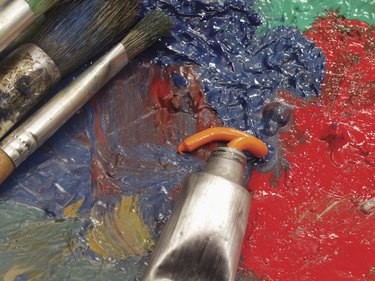Things You'll Need
Acrylic paint
Fine sandpaper
Canvas
Wood
Metal

If you are learning how to paint with acrylics, realizing the value of sanding with sandpaper is important. Sandpaper can be used with acrylic paints to repair mistakes, control texture, protect canvas fabic and even add effects. Be cautious to use fine sandpaper on your artwork, and feel free to experiment with the limitations and the uses of this creative tool.
Step 1
Sand your painting surface. Painting surfaces that require sanding can be metal, wood, and the acrylic gesso prime on a canvas. According to the Art Spectrum web site, gesso is a thin paint-like substance, usually either white or black, which is applied to a canvas surface to prevent oil or acrylic paint from soaking through the fabric. Down the line, fabric soaked in oil can become damaged. Applying acrylic gesso helps to prime and seal the canvas and protect it, but it also changes the texture and the surface of the canvas. Using fine sandpaper, you can work through any imperfections that the gesso has created on your surface, making the dried gesso more flat, smooth and ready for an application of paint.
Video of the Day
Step 2
Use fine sand paper. When painting with acrylics, especially if you're using an impasto method, there is a risk of creating unwanted textures in your painting that later have to be worked out. Fine sandpaper gently helps to smooth out the dried acrylic paint surface, evening out the face to remove any of those imperfections which were not intended. Dab some water onto the painting surface before you begin sanding, as acrylic dust may be dangerous if inhaled. Wetting the acrylic helps to prevent this. Alternatively, you can soak the sandpaper in water before use.
Step 3
Use sandpaper to alter and control acrylic paint texture. Sanding is applied to acrylic paintings when the painter wishes to affect the finish of the acrylic paint. Dried acrylic paint has a finish that can appear reflective and sleek -- but if you want to give your painting a rough, more satin appearance, gently sand down the acrylic paint, just enough for the sheen to deteriorate to the desired level. But be careful: if you sand down the paint too much, it's difficult to fix.
Step 4
Play with sandpaper and sanding to create special effects. According to Lisa Cyr, artist and author of the book "Art Evolution," artists can sand acrylic paint to create a time-worn, aged look to their artwork that is both emotional and atmospheric. Spraying or dripping paint onto a canvas, let it dry and use fine sandpaper to rub and scour the paint. Or use sandpaper to wear down one coat of paint, revealing another color, or a picture, beneath. Purposefully distressing and aging the paint creates a rustic and powerful look, and can be seen in the works of other modern painters beside Cyr, such as Cynthia von Buhler and A. E. Ryan.
Tip
Use somewhere between 100 to 120 grit sandpaper.
Warning
Avoid using rougher or high grit sandpapers, as they may damage your painting or canvas when used too vigorously.
Video of the Day